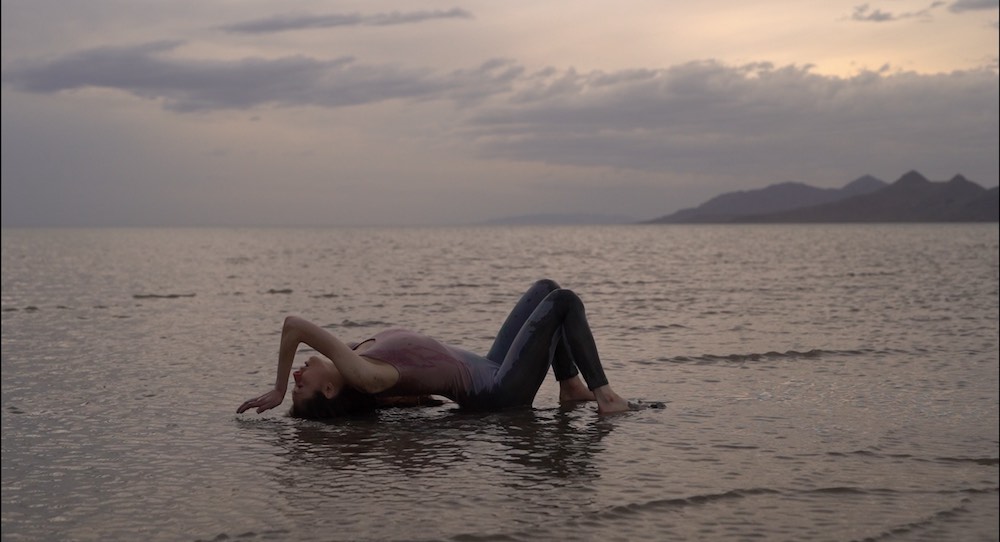Advocacy and activism through art is nothing new – but Artists Climate Collective demonstrates a dynamic and forward-thinking model for such work. As just one prong of their many-pronged approach (see also: sustainable dancewear, tote bags, and digestible climate change education through their social media channels), the organization released two films over the past year. The two films present a different vision of activist art. The efficacy of each up approach for debate, yet both these films are intentional and commanding in their chosen vein.
Darian Kane’s O Superman, Come Home (October 2023) offers an enticingly subtle environmental message, wrapped in thoughtful and measured postmodernism. It begins with a young man (Santiago Bedoya) walking in a forest. As he walks, we see close-up shots of tall grass and rain-dropped leaves: that familiar feeling of being out in nature and taking small moments to look more closely (direction from Alec Zais, film work and editing from Kenneth Trujillo, coloring from Samuel Hobbs).
As he explores further into wild terrain, he experiences more of its wonder – but also its lack of concern for human needs and norms. The score (“O Superman” from Laurie Anderson) translates that co-existence of calm and tension: with mantra-like repeated chords, but also a certain uneasy edge to its timber. Lyrics are soft, almost inaudible – but they speak striking messages about how we relate to each other, technology, and the present moment.
A young woman in white approaches (Ashley Wegmann): pure, pristine, potentially angelic. She reaches for the young man’s hand, and that leads the film into a new setting – a second section. They begin to dance, with nothing around them but bare walls, a mirror, and small stringed lightbulbs (Set Assistant: Gabriel Trujillo). He also now wears white; has her purity and grace shone unto him?
The mirrors project their reflection, and some shots show them through that reflection rather than directly. That bursts with potential metaphor and meaning: of what is seen and unseen, of what is refracted and what is whole, of what is and is not directly faced. The visual effect is also simply beautiful, highly memorable and affecting.
Kane’s movement vocabulary surfaces further dualities. Juxtaposing gestural intricacies and athletic lifts are simpler, softer moments: to simply walk, to gaze, to be 200 percent present. I think about how maybe that’s what this moment in history calls for, to truly heal our relationship with each other and with the earth: to slow down, to be present, to listen, to feel. Whether or not, Bedoya and Wegmann realize those opposing qualities with inspiring commitment.
Our last moments in this stark world have the young man dancing a more frenetic solo. He moves in a beautifully integrated way, yet one driven by some unsettled passion. The very last we see of him is back in the woods, pleading to the heavens for help to merely light a fire. Is this a vision? A memory? A dream?
It’s one of those endings that can have you sitting silent while you watch: attuned, pondering, knowing that powerful meaning is there – and searching for just what this is for you. I’d say that’s also true for the film as a whole.
Kara Komarnitsky’s tenacious, imagistic LAKE BODIES (August 2024) has a similar message – yet comes out with it much more forcefully. It also has a similar opening: a close up of tall amber grass, leading into one person’s footsteps. Those are of a Grim Reaper-type figure, faceless and cloaked in black.
As the figure (Severin Sargent-Catteron) begins to move, its long sleeves extend sharply angular shapes. There’s a spooky mystery to the movement quality and overall aesthetic. A voiceover describes a massacre of Indigenous peoples at this very site. Death hangs heavy in this air.
The film cuts to this dancer with wings on her sleeves, moving in a muddy lake bed. Her arms gracefully create various arcs, as if she is in slow flight. The camera zooms in on simple, clear footwork of shifting weight, toes pointed. Less is certainly more here (and that can be particularly true of dance on camera). The uncomplicated quality at hand is also evocative in relation to the theme of accepting less in life, in alignment with nature’s rhythms. That’s all in sharp contrast to the hooded figure of death.
A third section has this woman dancing in shallow lake waters, awe-inducing mountains in the distance. She moves through clear shapes that reference sea flora and fauna, arches her back like a fish out of water. Through voiceover, she marvels at nature’s beautiful complexity.
The film’s final image is her lying supine, peaceful in the lake’s embrace. In that moment, it provides all that she needs.
Taken together, these two films demonstrate separate approaches to artmaking: one more abstract, open to interpretation…and the other in no way shying away from what it seeks to convey. One has visuals that imply, the other with imagery that can’t be mistaken. One has poetic, mysterious lines in the score, the other a voiceover making strong, grand calls to action.
Perhaps one could make an argument for either approach…and no one approach aligns with every artistic vision. Yet what most often speaks to me more is softer, more flexible, more trusting in audience members to come away with their own valuable art encounters.
Arguably, that’s how we as artists are best positioned to drive change: to help guide people to their own highest truths and greatest strengths. Artists Climate Collective and collaborators are doing that work in various, and thoughtful, ways. The ripples can only expand from there.
By Kathryn Boland of Dance Informa.















